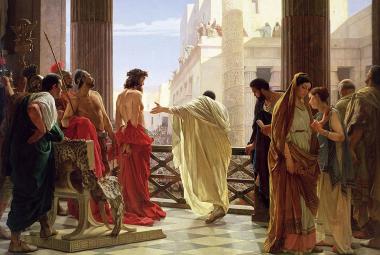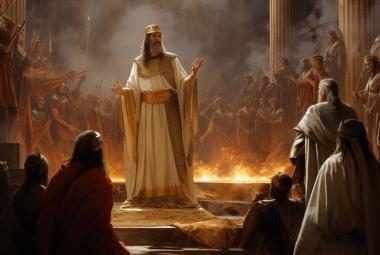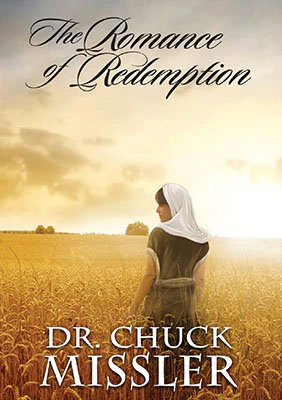The Book of Ruth is a classic love story of loyalty and devotion, and yet it also contains some surprising insights that go far beyond the historical narrative itself.
It is fitting that in a month that celebrates love, our newest release is on the Book of Ruth. It’s a love story because Ruth falls in love with Boaz—that’s the main plot line. But overlaying that is the ultimate Love Story, a love story written in blood on a wooden cross, erected in Judea two thousand years ago.
This little four-chapter book is often studied (even in [secular] colleges) as a masterpiece in miniature for its romantic elegance and literary value—and its charming glimpse into life in ancient Israel.
It also reveals a craftsmanship of prophetic anticipation unrivaled anywhere in Scripture. One cannot really comprehend what is going on in Revelation Chapter 5 unless one understands the events involved in the Book of Ruth in the Old Testament.
A Classic Romance
It is a classic love story of loyalty and devotion, and yet it also contains some surprising insights that go far beyond the historical narrative itself.
One of the principal characters is Naomi, a Bethlehemite, who, because of a famine, migrates with her husband and her two sons to distant [Moab]. The two sons take Moabite women for wives. During the ten years that follow, Naomi’s husband and both her two sons pass away, leaving her destitute.
Upon hearing that things have turned for the better in her native Bethlehem, Naomi decides to return home. She encourages the two young girls to make new lives for themselves among their own people. One decides to do just that. However, Ruth refuses, insisting upon remaining with Naomi, declaring one of the most famous commitments in the Holy Scriptures:
Intreat me not to leave thee, or to return from following after thee: for whither thou goest, I will go; and where thou lodgest, I will lodge: thy people shall be my people, and thy God my God: Where thou diest, will I die, and there will I be buried: the LORD do so to me, and more also, if ought but death part thee and me.
Her persistent and devoted commitment to her mother-in-law leads to a dramatic romance, a prophecy of the coming King, her being included in the family tree of the Messiah, and her story also yields an incredible overview of God’s plan of redemption!
Laws of Ancient Israel
Upon returning to Bethlehem, Ruth encounters the hero of the tale, the handsome landowner, Boaz. To follow the narrative, one must understand several of the ordinances of the Torah and their associated customs: The Law of Gleaning,[1] the Law of Redemption,[2] and the Law of Levirate Marriage.[3]
The Law of Redemption
To pick one example, let’s explore the Law of Redemption. In ancient Israel, land wasn’t sold in fee simple[4] as we are used to. Since God was the real landowner, Israel was simply a tenant under conditions of obedience. When land was “sold,” what the buyer received was only the use of the land, not clear title. There were conditions under which a kinsman of the seller could “redeem” the land back to the original family. These conditions were typically noted on the outside of the scroll defining the transaction.[5]
The scroll in Revelation Chapter 5 was written “within and on the backside,” which identifies it as a deed subject to redemption. A Kinsman of Adam, in His role as a goel, a Kinsman-redeemer, is taking possession of what He had already purchased with His blood as the sacrificial Lamb. He not only purchased the land; he also purchased a Bride.
Boaz is not only the “lord of the harvest,” he also saves the day by performing the role of the “Kinsman-redeemer.” By his intervention, the forfeited lands are returned to Naomi, and he takes Ruth (a Gentile) to be his bride. How could Boaz marry a Moabitess? The Law legally forbade intermarriage,[6] especially to a Moabite.[7] Remember who his mother was: Rahab, the Amoritess that distinguished herself at Jericho![8] Both Rahab and Ruth are mentioned in the genealogy of our Lord. The Law shut Ruth out; grace took her in.[9]
An Incredible Macrocode
A macrocode (sometimes called a “macro” in computer-eze) is an anticipatory instruction defining the relevance of forthcoming events. (In a computer application, for instance, it can declare the format of a fax, email, or formal letter, etc.)
In Biblical literature, such allusions are sometimes called “types,” which foreshadow coming events in the future. The Akedah, Abraham’s offering of Isaac, is a classic example.[10] Two thousand years later, another Father did, indeed, offer His son as on offering on that very spot.
The other remarkable example is the Book of Ruth. Naomi can be viewed as a “type” of Israel; Boaz, of course, is the Kinsman-Redeemer, who by his act of redemption returns Naomi to her land and takes a Gentile bride, Ruth.
Once one has gained that perception, re-reading the book reveals a long list of insights from hidden details that illuminate God’s entire program of redemption!
There’s More…
This “macrocode” extends to virtually every detail of the book. It is interesting that Ruth is introduced to Boaz through an unnamed servant (functioning as the Holy Spirit).[11]
The Church, as the Gentile “Bride of Christ,” is introduced to the ultimate Kinsman-redeemer by the Holy Spirit also.
It is interesting that Ruth learns how to deal with this situation from Naomi. We learn of God’s plan of redemption through His dealings with Israel.
It is also provocative that, in the story, Naomi learns of Boaz through Ruth. (The implications of that subtlety is left to the diligent.)
The exposition of the almost-inexhaustible “coding” aspects of this tiny book exceeds the space available here. It is also interesting that this pivotal book is also associated with the Feast of Shavuot, the Feast of Pentecost.[12] Coincidence? Hardly.
Prophetic Aspects
Why was Jesus born in Bethlehem? Why was David associated with the town of Bethlehem? The answers are in this little four-chapter book.
How could Samuel, knowing from Genesis 49 that Judah was to be the royal tribe,[13] anoint Saul from the tribe of Benjamin? David wasn’t ready yet, even though he was prophesied in the Book of Ruth, in the time of the Judges.
Our exposition of the Book of Ruth has proven to be one of the most popular of all our publications. We have recently recorded it in four one-hour sessions, called The Romance of Redemption, and it is available this month on DVD.
Notes:
- Lev 19:9, 10; Deut 24:19, 21. ↩
- Lev 25:47–50. ↩
- Deut 25:5–10. ↩
- A fee simple estate of inheritance is one which devolves to the owner’s heirs and assigns forever without limitation. ↩
- An example of this was when Jeremiah, despite the impending Babylonian captivity, was instructed to purchase land from the son of his uncle Hanameel. He, of course, would never benefit from this purchase. The deed was secreted in an earthen jar in anticipation when his heirs would return after the captivity and claim it (Jer 32:6–15). ↩
- Deut 7:2,3. ↩
- Deut 23:3. ↩
- Josh 2:1–22; 6:17, 23–25; Heb 11:31; James 2:25; Mt 1:5. ↩
- Rom 8:3,4. ↩
- Gen 22. ↩
- It is interesting that the Holy Spirit always is modeled as an “unnamed servant”: In Genesis 24 He gathers a bride for the son. (He is unnamed in Ch.24, but we learn His name in Ch. 15: it is Eleazar, “Comforter”). He “shall not speak of himself” (Jn 16:13). ↩
- See our Topical Study, The Feasts of Israel, for the prophetic implications of each of the seven feasts of the Torah. ↩
- Genesis 49:8–10. ↩







